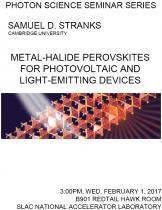Speaker: Samuel D. Stranks, Cambridge University
Program Description
Metal halide perovskites such as methylammonium lead iodide (MAPbI3) are exotic hybrid crystalline materials developed out of curiosity. Unexpectedly, solar cells and light-emitting diodes (LEDs) incorporating these perovskites are rapidly emerging as serious contenders to rival the leading technologies. Photovoltaic power conversion efficiencies have jumped from 3% to over 22% in just seven years of academic research, and we’re witnessing a similarly astonishing pace in LEDs. Here, I will give an overview of some of the key advances that have led to these efficiency breakthroughs. I will then focus on recent photophysical advances to better understand the optoelectronic behavior of the materials and operation of the state-of-the-art perovskite solar cells. I will cover topics including charge carrier diffusion and recombination mechanisms, as well as ion migration and its potential impact on device performance. Understanding these processes is key to further development of the field and to bringing the perovskite technology to commercialization.
Bio
Sam Stranks is a Royal Society University Research Fellow and TED Fellow in the Cavendish Laboratory, University of Cambridge. He completed his PhD at the University of Oxford in 2012 with Prof. Robin Nicholas investigating organic solar cells. He then focused on the optoelectronic properties of perovskites while working with Prof. Henry Snaith and holding a Junior Research Fellowship at Worcester College. From 2014-2016, he was a Marie Curie Fellow at MIT, USA. He was awarded the 2016 IUPAP Young Scientist in Semiconductor Physics Prize for “pioneering discoveries in the field of perovskite solar cells and optoelectronics through spectroscopy”.





